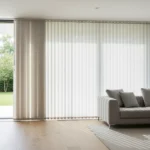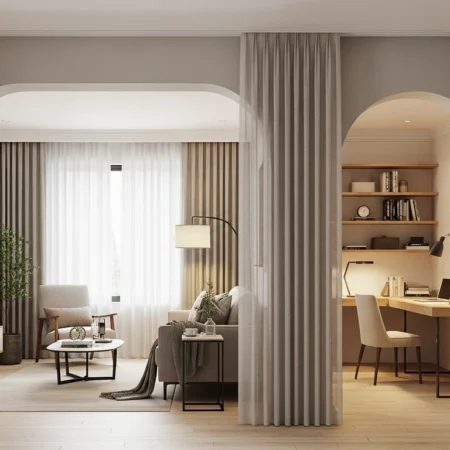If you’ve ever tried to make one room behave like three, you already know the quiet chaos of rental living. Maybe your bed sits a little too close to your sofa, or your “office” also happens to be the kitchen counter. I’ve been there myself, negotiating with a wide-open studio and thinking, Surely there must be a way to carve out a little privacy without drilling holes and summoning the wrath of my landlord.
The good news? There is. With a few clever, renter-friendly room divider ideas, you can shape your space into something that feels intentional, comfortable, and genuinely yours. Whether you want a cozy sleeping nook, a focused workspace, or just a way to hide the laundry chair we all pretend we don’t have, you’ll find something here that works. And the best part: every idea in this guide keeps your walls pristine and your security deposit safe.
1. Tension-Rod Curtain Wall
A tension-rod curtain wall gives you instant privacy without making your landlord twitch. It works beautifully around a bed or workspace and lets you choose how much light you want—sheer for softness, blackout for true separation. It also comes down in minutes when you’re ready to rearrange or move, which is always a win in rental life.
Here’s what makes it work:
• Creates a soft, cozy boundary without closing the room off
• Easy to adjust or remove with zero wall damage
• Works with almost any style depending on your curtain fabric
2. Double-Duty Open Shelving Divider
An open shelving unit creates a clean, effortless divide while giving you extra storage—something every renter quietly craves. The best part is how airy it feels; the shelves separate your zones without stealing the sunlight. Style both sides with books, baskets, or a few plants to make each area feel polished and intentional.
Pro tip: Add felt pads under the base so the shelf glides easily without marking your floors.
3. Folding Screen That Packs Away Flat
Have you ever wished you could make your bed disappear when friends stop by? A folding screen comes pretty close. It adds instant separation, looks stylish, and quietly folds away when you want your space open again. Choose materials like rattan or fabric panels to keep the room light and breathable.
Quick steps:
- Unfold the screen where you want privacy
- Angle it slightly for stability
- Fold and tuck it behind the sofa when not in use
4. Plant Jungle Divider on Stands and Racks
A plant wall instantly brings life into a rental, and it doubles as a gentle divider that feels more like a calming retreat than a boundary. Mix tall palms, leafy statement plants, and trailing vines to build height and texture. The greenery softens the space while still letting light filter through, which keeps your apartment feeling open instead of boxed in.
What you’ll need:
• A few tall floor plants
• Mid-size leafy varieties for layering
• Stands, racks, or staggered pots to vary the height
5. Clothing Rack Turned Cozy Divider
A clothing rack makes a surprisingly effective room divider, especially when you want storage and separation in one move. Hang your most cohesive pieces—or add a simple fabric panel—so the rack feels intentional rather than like overflow storage. It works especially well between a bed and living area, giving each side a bit of breathing room.
Pro tip: Choose matching hangers and keep a soft color palette so the divider looks styled, not cluttered.
6. Area Rug + Furniture “Invisible” Divider
Unlike bulky partitions, this approach uses rugs and furniture placement to signal where one zone ends and another begins. A rug under the sofa instantly defines a living area, while a different texture under the bed creates a quiet sleeping corner. This trick keeps the room open, stylish, and easy to navigate without adding any physical barriers.
For instance: A bold patterned rug in the entry and a softer woven one by the bed make each space feel distinct without blocking a single ray of sunlight.
7. Freestanding Slatted or Panel Screens on Bases
A freestanding panel divider gives your apartment that “architect-designed” feel without any drilling or commitment. These screens stand solidly on their own base, so you can angle them for extra stability or style. Some even come with built-in shelving, which turns a simple divider into a useful piece of furniture.
Why it works:
• Adds structure without blocking all the light
• Easy to move whenever you rearrange your space
• Leaves walls completely untouched—your security deposit stays safe
8. Macramé or Beaded Divider on a Tension Rod
A macramé or beaded divider adds texture, movement, and just enough separation without closing off the space. It’s perfect when you want a visual cue—like marking an entryway or softening the border between a desk and living area—without blocking light. The whole setup feels relaxed and artistic, almost like your apartment suddenly learned how to exhale.
What makes it special:
• Creates separation while keeping sightlines open
• Adds instant personality with minimal effort
• Hangs easily from a tension rod—no holes required
Rental-Safe Setup & Safety Tips
Setting up room dividers in a rental feels a bit like threading a needle—you want style and function, but you also want your security deposit waiting for you at move-out. A few simple precautions keep everything safe, sturdy, and landlord-approved. Start by adding felt pads under shelves, screens, and bases so you can slide things around without scratching your floors. It takes ten seconds and saves you from a thousand tiny regrets later.
Make sure you never block air vents, radiators, windows, or walkways. A divider should make your space feel more comfortable, not turn it into a maze you stumble through at midnight. If you use tension rods, double-check the weight limits and give them a quick twist every so often to keep them secure. For larger pieces like freestanding screens, a removable adhesive pad or furniture strap adds stability without leaving marks.
And if you’re ever unsure, snap a quick photo and send it to your landlord. Most love a tenant who cares enough to check first—plus, it keeps everything transparent. Good design is fun, but safe design is what lets you enjoy it.
Quick FAQs About Room Dividers in Rentals
1. Can my landlord say no to room dividers?
Most landlords care more about permanent changes than temporary setups. Freestanding screens, curtains on tension rods, and open shelving units usually fall well within rental rules because they don’t leave marks behind. Still, every lease is different, so a quick check or message keeps things simple and avoids misunderstandings later.
2. How do I divide a room without blocking light?
Light-friendly dividers make all the difference. Try sheer curtains, open bookshelves, or a plant wall that filters sunlight instead of trapping it. Have you ever noticed how even a tall palm lets light slip through while still giving you privacy? That’s the sweet spot you’re aiming for.
3. What’s the best divider for a tiny studio?
In small spaces, flexible options win every time—folding screens, tension-rod curtains, or clothing racks you can roll aside when you need more room. Look for multipurpose solutions, too. A shelf that stores your books and separates your bed from the sofa earns its floor space twice over.
4. Are there budget-friendly divider ideas?
Absolutely. Curtains on tension rods, thrifted folding screens, and DIY plant clusters can all stretch your budget surprisingly far. Even rearranging what you already own—like shifting your sofa to face away from your bed—can create a fresh sense of separation.
Conclusion

Room dividers are one of the easiest ways to transform a rental without drilling, renovating, or losing your deposit. Whether you choose floating curtains, a chic folding screen, airy shelving, or a cluster of tall plants, the right divider reshapes your space instantly—giving you privacy, flow, and that “my home actually makes sense now” feeling.
The best part? Every option you’ve seen is landlord-friendly, reversible, and adaptable for future apartments. Your studio can feel intentional, stylish, and spacious with just a few thoughtful choices. Have fun experimenting, rearranging, and customizing until it feels completely you.










